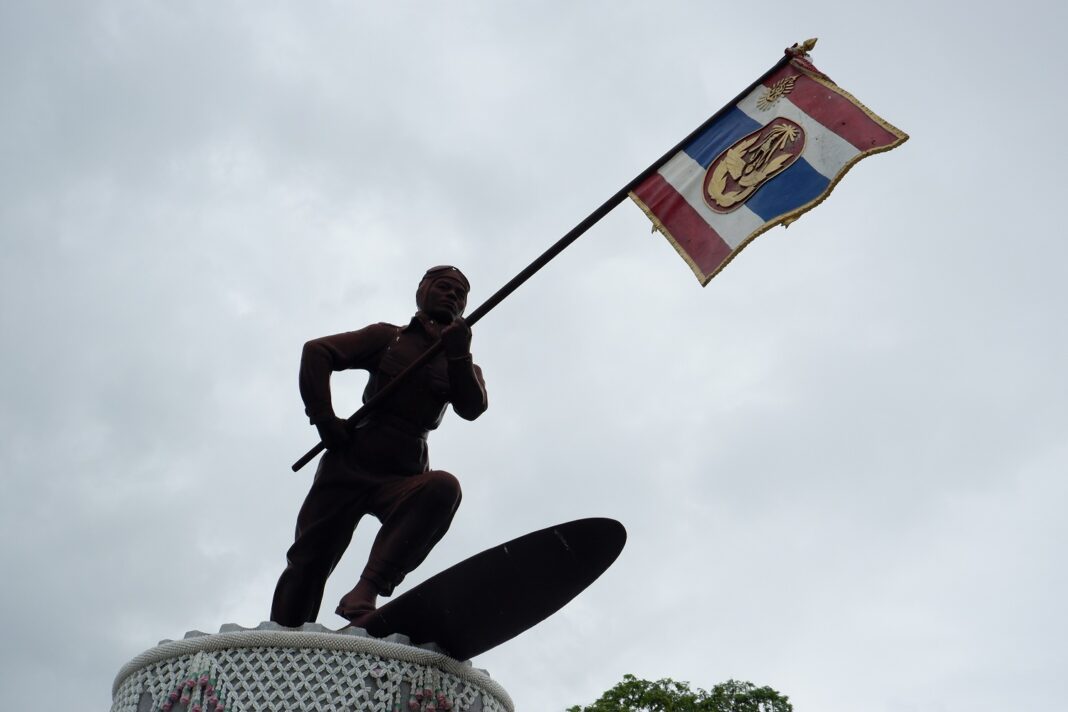Above: A monument to the defenders at Wing 5 base in Prachuap Khiri Khan province.
In the darkness over the sea, air force lieutenant Srisak Sucharittham heard the enemies before he saw them.
It was 4am. Srisak and his friends had woken early to set out from their airbase to the nearby bay of Ao Manao. A senior officer was slated to visit their base, home of the Wing 5 Squadron, in the evening. So Srisak’s group went to catch fish for a welcome banquet.
Then he heard a sound: the rumble of engines. Unknown ships were entering the bay. Convinced something was amiss, they turned back and sounded the alarm. Dec. 8, 1941 had dawned on Thailand, bringing with it the flames of war.
“I was the first to see the barges. They were almost ashore, about 100 meters away,” Srisak said in an interview recorded before his death last year. “I ran to tell my wing commander to blow the emergency bugle and alert the wing.”
Less than four hours after crippling the US fleet at Pearl Harbor, tens of thousands of Japanese troops landed on Thai shores in their campaign to conquer Southeast Asia. Like the attack on Hawaii, the invasion caught the nation unprepared, and the Thai government led by Field Marshal Plaek Pibulsongkram quickly sought a ceasefire.
But while the rest of the country laid down arms, Srisak and a small band of 120 soldiers at the Ao Manao airbase resisted the invaders for 33 hours, unaware of Bangkok’s capitulation. Over a third would die by the end of the battle.
Distinguished by their courage in the face of overwhelming odds, they remain the only air force unit to be awarded with the Medal of Honor to date.
A DYING HISTORY
Rain was falling on a recent visit to Ao Manao – Lime Bay, in English – on a recent afternoon.
The bay stretches, from south to north in a long curve, with its northern reach curling eastward to end at the foot of Khao Lom Muak, a 300-meter limestone mountain that towers over the harbor.
The bay is now under the military jurisdiction of the Wing 5 base, the home of a squadron responsible for guarding the airspace over Prachuap Khiri Khan province. It sits on the western side of the Lom Muak peak.
There is only one air force-owned hotel on the beach. Driving north toward the bay from the hotel, one would pass a small hill on the left – Wua Ta Lueak – before the road starts to curve sharply along with the beach toward Lom Muak.
It’s here that the Japanese landed, in full view of these two flanking hills.
After passing through a checkpoint at the base entrance, the road runs north through the base, leading to the beach of another bay, Ao Prachuap. The road then continues along the coast toward the seaside town of Prachuap Khiri Khan.
Unlike the wide expanse of the Ao Manao, the sea in Ao Prachuap is interrupted by a chain of three islands. From February to July every year, a midday low tide exposes a long shoal that connects the islands together with the mainland. But the sea in the two bays would have been at high tide that fateful December morning.
“It means the invading force could land their barges very close to the shore,” Sumalee Posri, a curator at the base’s war museum, said as she led a tour. “The Japanese must have done their research.”
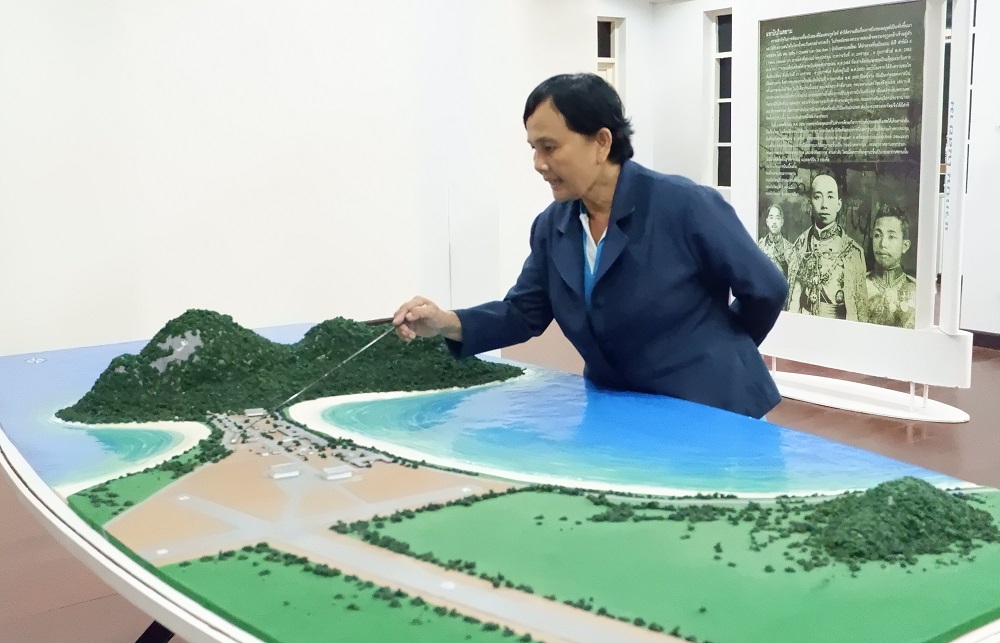
Facing Ao Prachuap is a group of buildings and monuments forming the museum complex. They include a memorial honoring the airmen who died fighting the Japanese on this shore. Their enemies were buried in unmarked graves beneath the trees along the beach. A Thai styled shrine was erected for their souls.
Sumalee has been curating the museum for 47 years. In the early years of her career, she remembers families of the Japanese dead visiting the beach and lighting incense in rituals to bring their spirits home. Those pilgrimages trickled to a stop many years ago.
“Their relatives are probably dead by now,” Sumalee said.
Throughout her career, Sumalee has interviewed survivors of the battle to describe to visitors what happened that day. Some interviews were recorded and put on display at the museum. An invaluable anecdote, as many veterans have died.
“She’s supposed to retire five years ago, but we couldn’t find a replacement for her,” Wing 5 commander Col. Anirut Ruthrattorn said. “So we asked her to stay.”
Every year the battle is commemorated at the base. The veterans also attended the event, though their number had dwindled in recent years due to illness and deaths.
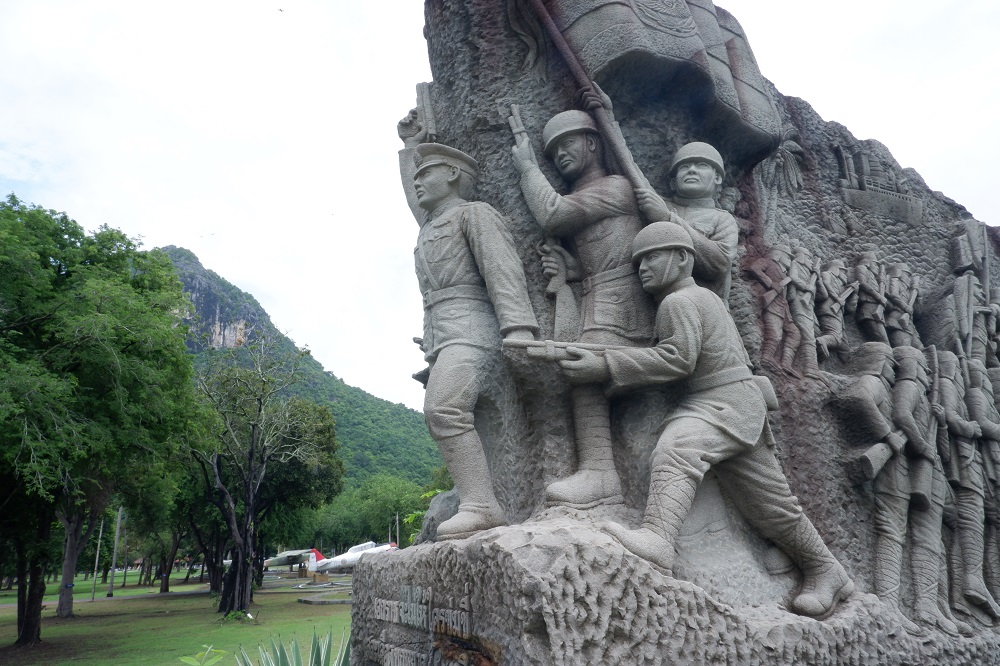
In the latest ceremony, only one was well enough to show up: Prachuap Chalardpad. He’s one of only three veterans still alive today. Other two are Suan Pongsiri and Choi Lodthanong. Srisak died in May 2017. He was 100.
In a recent visit to Choi’s family home in Sam Roi Yod district, the 98-year-old veteran was too unwell to answer a reporter’s questions. On a wall hangs a portrait of Choi as a young man in army uniform. Another shows him and other veterans at a gathering in Wing 5 base.
Despite the yearly fanfare at the base, the officials apparently overlooked its museums, which are now in disrepair. Visual effects meant to recreate the fighting no longer function. Several artifacts are missing. The air force hasn’t approved a maintenance fund for years, Sumalee explained.
ROAD TO WAR
The invasion in December 1941 came as a surprise to many Thais not because war at last came to Thailand. The government under autocrat Plaek Pibulsongkram spent months drumming up a militarist rhetoric, telling the population to prepare for war and sacrifice for their country.
The surprise was who Thailand would end up facing as the adversary. Many people expected to fight the Western powers – French or British, perhaps – not Japan.
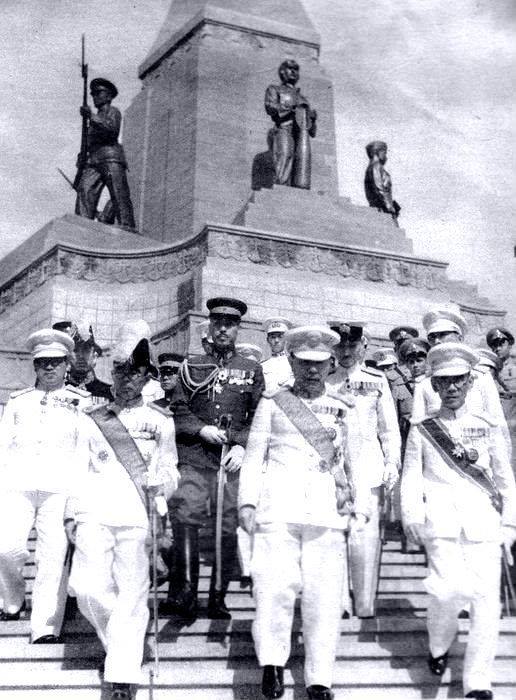
“Srisak once told me he knew war was coming, but he didn’t think it would be the Japanese,” Sumalee said. “Thailand and Japan were allies.”
Friendship between the two nations was forged after Thailand invaded French-held Indochina in 1941 to reclaim territories it lost half a century ago. After Thai armies won a series of victories, Japan – a superpower at the time – stepped in to mediate a ceasefire agreement, which carved up parts of Indochina and handed them over to Thailand.
That helping hand convinced much of the public that Thailand was better being aligned with Japan, who was calling on Asian nations to unite within its “Co-Prosperity Sphere” and rise up against the Western colonizers.
Leaders in the government and armed forces also had close ties to Japan, said Chalong Soontravanich, who teaches history at Chulalongkorn University. Japan not only trained Thailand’s corps of officers and pilots, but also sold the nation three submarines.
“I think the Thai armed forces were fully aware that Japan’s military might was vastly superior,” Chalong said in an interview in the century-old university, one of the buildings seized by the Japanese to house its troops in Bangkok during the war. “Japan was recognized as a superpower after its victory in the Russo-Japanese War.”
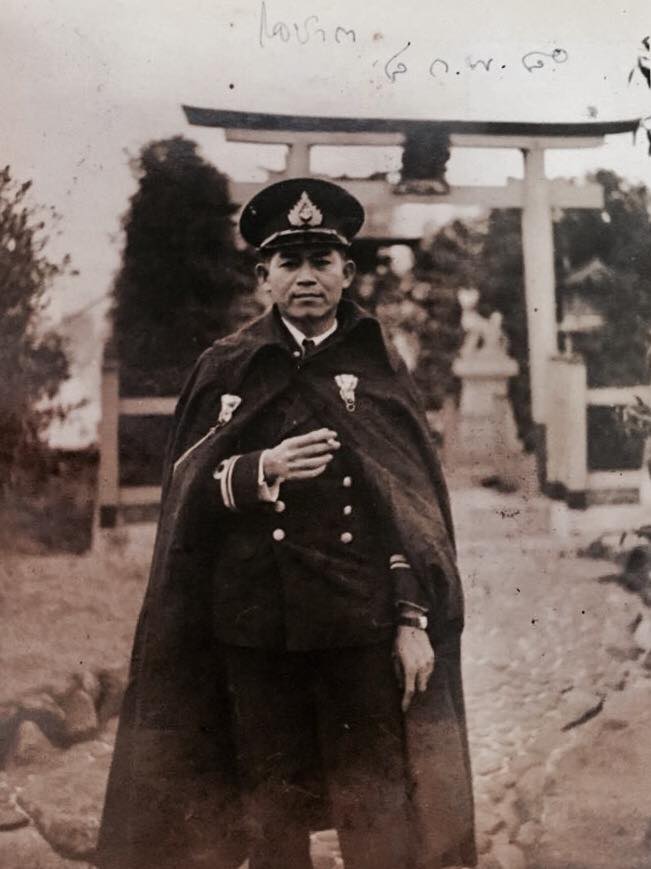
But behind the guise of cooperation, Japan plotted invasion. Agents posing as tourists rented fishing boats to survey the coasts and measure their depths. Japanese construction companies and pharmacies stockpiled materials for the invading armies, while photography workshops collected maps and pictures of strategic landmarks.
“There are many anecdotes about when the war broke out, these professionals changed from their gowns into army uniforms,” Chalong said. “I think the Thai authorities were aware that Japanese spies had infiltrated their country, but they couldn’t do anything.”
At the Wing 5 base, Sumalee recounted a story passed to her by a veteran. Like many other units, the squadron in Ao Manao was trained by Japanese pilots. After the training was completed, one Japanese instructor gave ominous parting words to his Thai students: We shall meet again.
THE INVASION
Wars and battles were probably the last thing on people’s minds on the eve of the invasion, because it was a time for festivities.
Fairs to observe Constitution Day – Dec. 10 – already kicked off early in some parts. The holiday marks the first formal charter installed after Plaek and other coupmakers overthrew absolute monarchy nine years earlier.
“When November came, all we talked about was the Constitution Day fair and Miss Thailand pageant,” Sorasai Paengsapa, a Chulalongkorn student at the time, wrote in his memoir. “We didn’t see any sign of war or enemy, north or south. The atmosphere was of joy.”


But while Bangkok’s streets were full of lights and revelers, the small town of Prachuap Khiri Khan would have most likely slept through the night. It had no cinema or theatre. After all, it was little more than a stop on the rail line connecting the capital with the south, with an airbase to guard Thailand’s border with Burma, which lays just 20 kilometers west.
Unbeknownst to the Thais, a Japanese armada of battleships, cruisers and landing craft had left a port in Vietnam and sailed for Thailand two days earlier. On the night of Dec. 7, the invasion force somehow slipped past a Thai navy patrol, led by the HTMS Sri Ayudhya, and separated into seven fleets, each bound for provinces along Thailand’s gulf coast.
One such force anchored east of Lom Muak Hill, where 3,000 soldiers boarded landing barges to storm the beaches of Prachuap and Manao bays. The time was 4am.
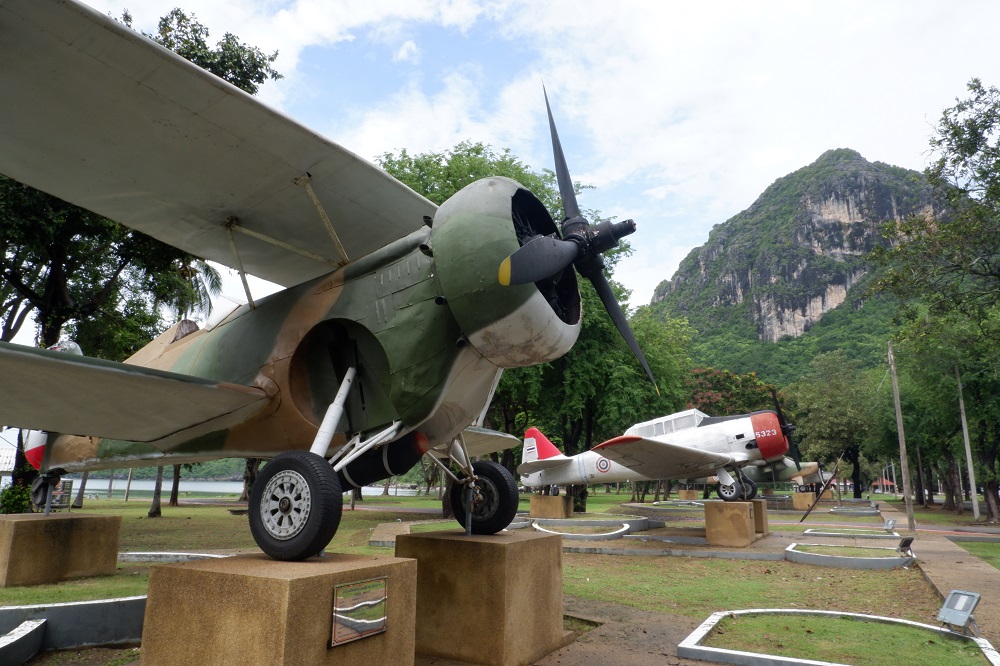
In the dark, the Japanese infantry disembarked on Prachuap Beach and spread throughout the town before policemen at their station shot at them, waking the townspeople from their slumber.
Grabbing whatever firearms they could, the police and the residents sought cover along the town’s main street and fired at the Japanese. The road was later renamed Su Suek – Fighting a War – to mark the brief shootout. The invaders quickly defeated them, taking the town’s railway and telegraph station.
One objective was down. Another force was beating against rough December waves toward the second goal: the Wing 5 air base.
‘I DON’T KNOW HOW MANY DIED’
That’s when Srisak and his fishing group spotted the enemy. He alerted the commander, Maj. Prawat Chumsai, who ordered a fight.
Srisak and Prawat went back a long way. Srisak said in his recorded interview that he signed up for the air force after he saw a warplane land in his hometown of Chiang Mai as a young boy. It was the first time he ever saw a plane, and the sight left him fascinated. As he learned later, Prawat was the pilot of that plane.
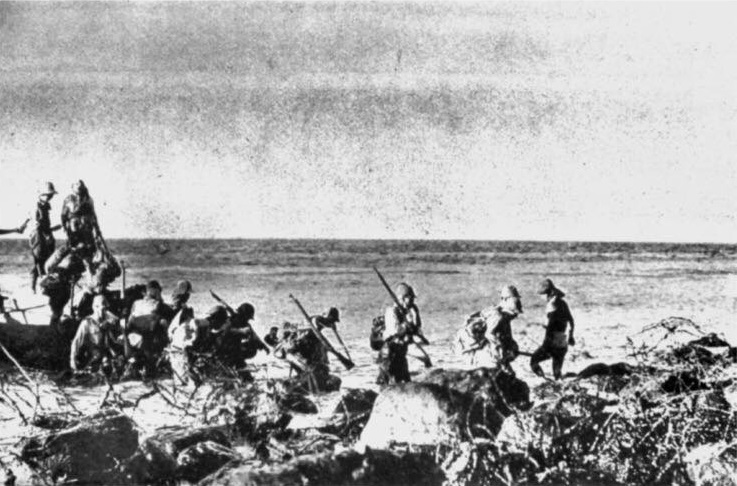
Apart from a handful of pilots, Prawat’s men were low-ranking troops belonging to arkatsayothin, an air force unit trained in infantry tactics to protect airfields from enemy attack.
Except for Prawat, who flew in missions during the Thai-Franco War, they had no combat experience. The base’s small arms consisted of only about 100 Arisakas, a bolt-action rifle made by Japan, as well as nine machine and submachine guns.
But they weren’t exactly caught off guard. Sensing war might come to Thailand, the garrison had staged combat drills and built basic defenses around the base. Machine gun nests were placed on Lom Muak and Wua Ta Lueak hills, offering a sweeping field of fire that covered the airstrip and Manao Bay.
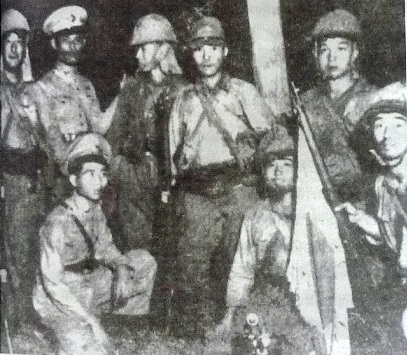
“We knew there would be a war. We already made preparations,” veteran Jong Maliwan says in a videotaped interview shown at the museum. “Whether it would be Japanese or farangs, we didn’t know. Back then, we slept on the beaches and monitored the bay.”
After hearing the horn blown by Prawat, the defenders rushed to their positions. One group manned a machine gun team on Wua Ta Lueak. Another set up defense inside the airbase. A small number of policemen and Boy Scouts also joined them.
And then they waited. It’s only after first wave of invaders left their landing vessels that they opened fire.
“We fired at them from our hiding spots on the shore. I don’t know how many of them died,” Jong recalled. “They attacked us, so we had to fight. We didn’t know who was who.”
The odds were initially in favor of the defenders. Using trees as cover, they sprayed gunfire at the Japanese, who were exposed as they waded in the water.
But the situation turned grim for the Thais. The attackers, determined to take the base, braved the hail of bullets and pushed ashore. More Japanese troops also moved south from Prachuap town and attacked. The base’s sentry post was soon overrun, along with its radio station.
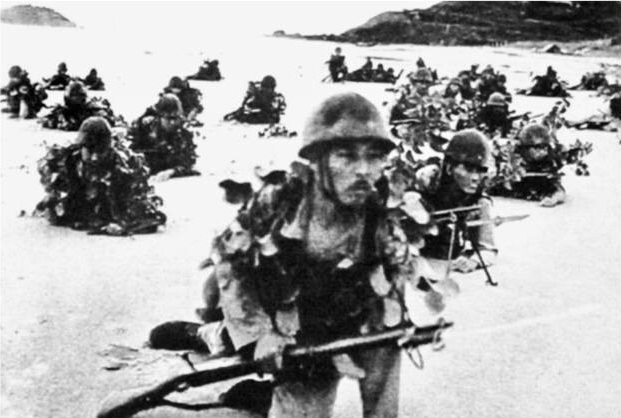
As the Japanese closed in on the airfield, the pilots tried to fly their aircraft away. They paid for it with their lives. Two pilots, Prom Chuwong and Jamnian Variyakul, were shot and killed as they were taxiing on the runway. Another was severely wounded, stabbed by a bayonet.
Only one pilot, Maen Prasongdee, managed to fly off with a Hawk-3, a bullet lodged in his back. He turned his US-built naval biplane north toward the capital to seek help, but his engines soon cut out and forced him to land in front of the king’s summer palace in Hua Hin.
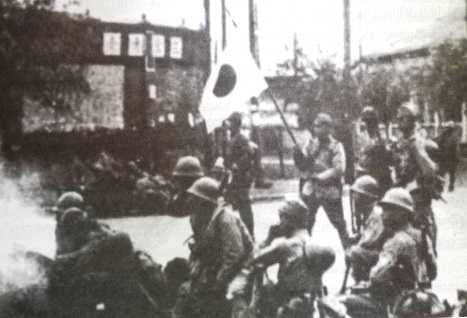
The base wasn’t only home to the fighting men, but also their families, who by then were cowering behind whatever shelter they could find. Two women – an officer’s wife and a housekeeper – were struck and killed by stray bullets. Some women and children had been moved up to Lom Muak hill, where they watched the hopeless battle unfold.
“When the Thai soldiers opened fire, we saw it,” Jamrern Sangkaew, an airman’s daughter who took shelter on the mountain, said in a 2012 interview. “There were splashes. The Japanese were falling down from their boat … the beach was soaked in blood.”
NO SURRENDER
The frontlines kept shrinking as more Japanese troops closed in. The fighting was so intense that bayonet brawls broke out in some places. Srisak recalled engaging in such fights three times.
Fatalities piled up, including a 15-year-old Boy Scout, Boonying Sirisathien, who was shot dead while racing from one foxhole to another with a supply of ammo.
Elsewhere, Japanese forces triumphed. Apart from Ao Manao, all the other beachheads had fallen. By late morning, they reached Bangkok’s outskirts after landing in the neighboring town of Samut Prakan.
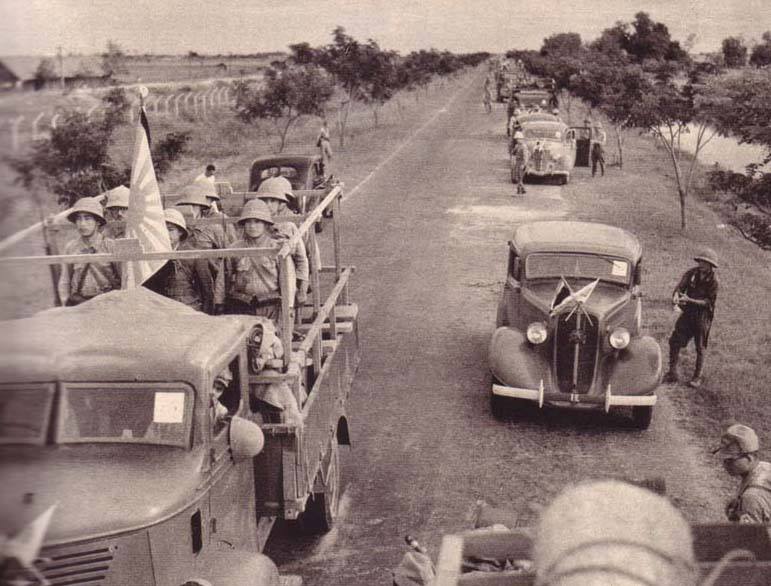
At about 10am, the cabinet convened an emergency meeting where they debated the course of action. After frontline briefings poured in – a report from Wing 5 mistakenly said they were under attack from “British-controlled Burmese troops” – the government concluded there was no point in more fighting.
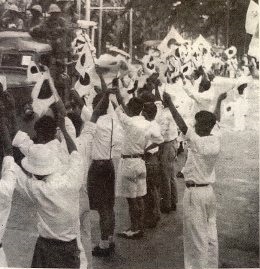
“We would manage to keep fighting for less than a year, and once we are defeated, militarily like this, our defeat will turn us into their slaves,” deputy prime minister Adul Aduldejjarus told the meeting. “We will become their colony, 100 percent.”
The meeting ended when Plaek agreed to call a ceasefire on the condition that Thailand would only allow “safe passage” to Japan – and not join or aid its wars against the Allies.
Under Japanese pressure, Plaek would later renege on that condition and declare war on the United States and Britain a month later.
The ceasefire was signed at 11:55am. Orders to stand down immediately went out to all fronts. Except for one place.
FRIENDS, NOT ENEMIES
Unaware of the order, the airmen of Wing 5 kept up their stubborn fight, though each hour that passed saw ground lost one yard at a time.
When it was clear they could not hold the base, wing commander Prawat ordered the buildings and fuel depot burned before retreating to make a last stand at the foot of Lom Muak Hill.
More than 14 hours had elapsed since the Japanese had made landfall. Fighting receded when night fell.
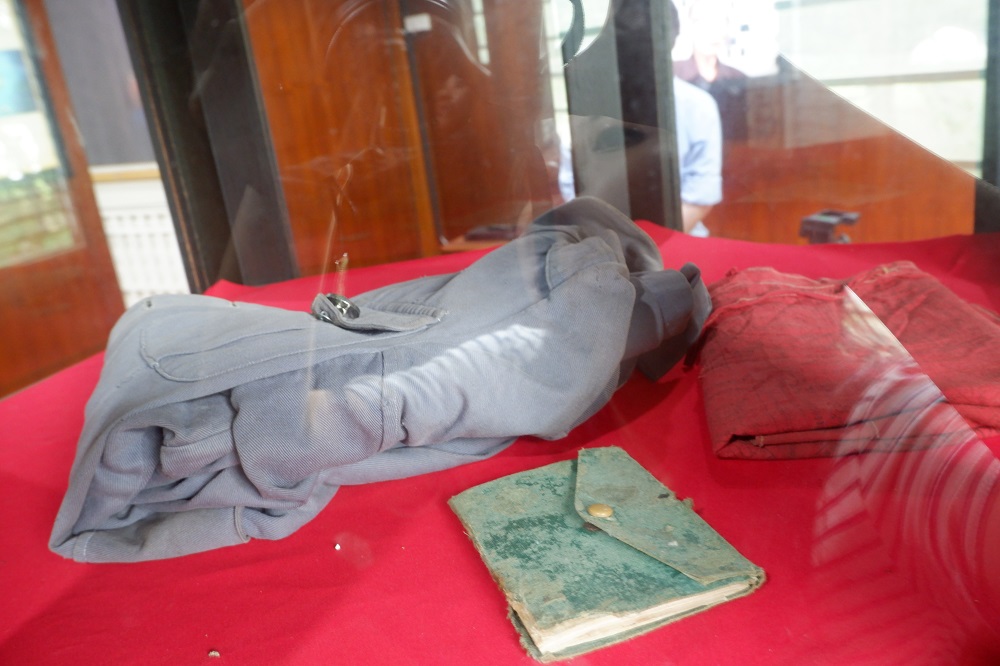
In the morning, Prawat must have realized that no help was coming. Nevertheless, an order went out at about 8am for the defenders to cheer news that the navy was almost there to relieve the siege. It wasn’t true, but Prawat hoped their cheering would scare the Japanese and delay their final assault.
But the Japanese did not attack. In his anecdote, Srisak recalled seeing someone in the Japanese trench suddenly raise his hand in a gesture of parley and walk toward the Thai side. Srisak guessed the officer was at least a lieutenant colonel, most likely the commander of the besieging force himself.
Shaking his hand, the enemy commander offered him an apology.
“He spoke in sketchy English. He said, ‘Sorry. Our enemies: Burma, English, American. Thailand, Nippon: friend. Tomodachi,’” Srisak said. He recognized the Japanese word for friend.
The officer then took out a sheet of paper. It was an order signed by the prime minister telling the Wing 5 force to lay down their arms. A formal ceasefire ceremony was held at noon inside the base, where Prawat exchanged bayonets with his Japanese counterpart.
Thirty-three hours after the first gunshot rang across Ao Manao, the battle was over.
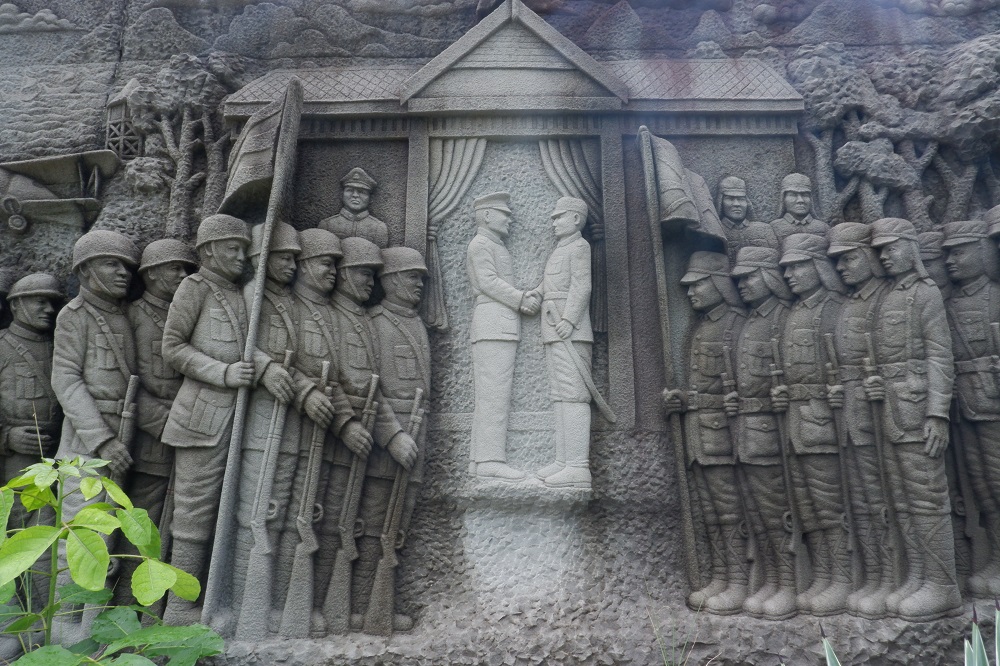
EPILOGUE
Their defiance came with a cost. Of the 120 soldiers holding the base, 38 were killed, in addition to a policeman, a Boy Scout and two civilians. Japanese losses were estimated much higher, between 200 and 400 personnel.
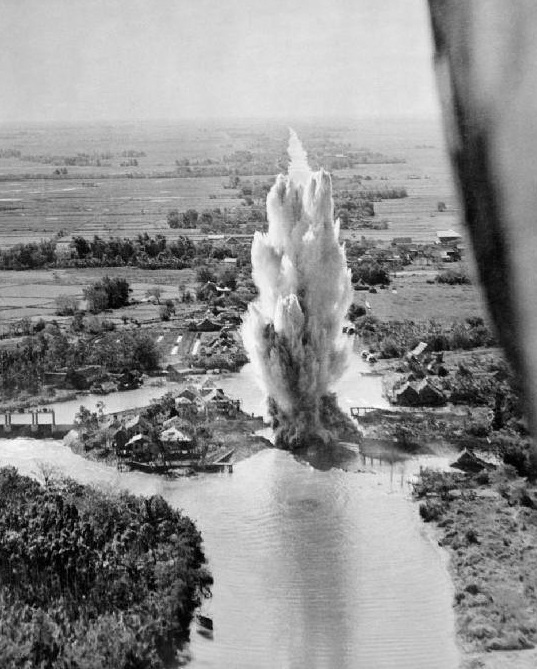
Thailand would remain under Japanese occupation for four years until Japan surrendered to the Allied forces in September 1945. Throughout the war, more than 5,700 Thais lost their lives, many of them caught in Allied bombing campaigns.
Ao Manao wasn’t the last resistance offered, as an underground movement called Free Thais was formed soon after the invasion. At the risk of firing squads, the volunteers spied on Japanese troops’ movement, passed messages between Allied forces, rescued downed pilots and smuggled weapons to prepare for an uprising against Japanese invaders.
The echoes of the war are still heard today, as Thai work crews or scavengers still have to contend with unexploded ordnance dropped during the conflict.
“The Allies saw us as enemies, which wasn’t a surprising thing,” Chalong the historian said. “But it was still fortunate that Thailand didn’t suffer as much as many countries … because we were out of bombing range once the Japanese invaded Burma.”
Prawat and his band of soldiers have somehow escaped popular culture. While there have been movies, TV dramas and fictional written accounts of the Japanese invasion of Thailand, none of them depicted the battle of Ao Manao.
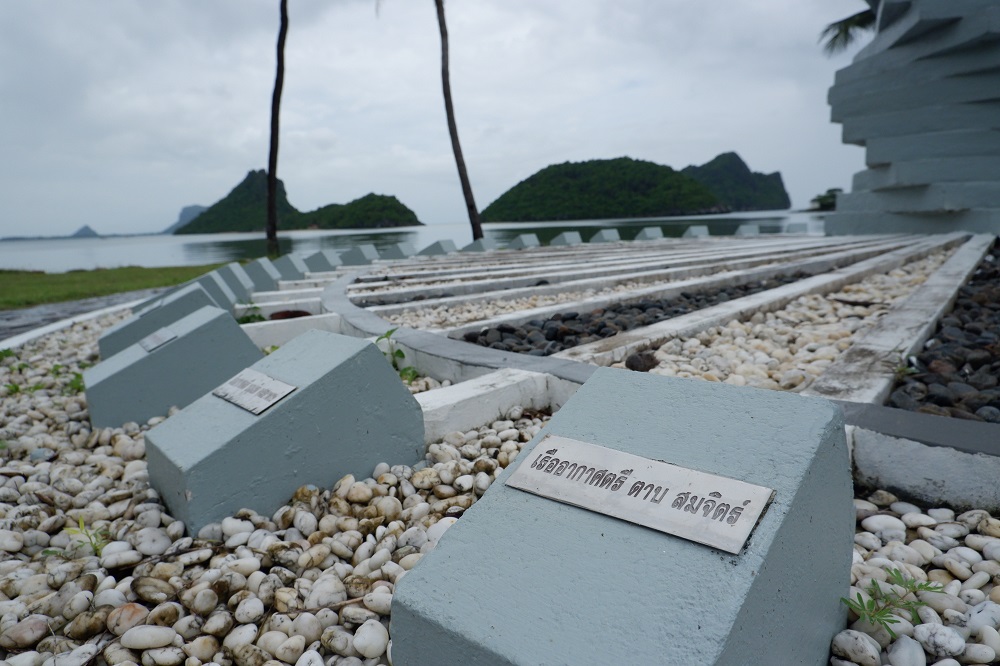
But the war is still remembered every year in Prachuap Khiri Khan, where a military parade is held every Dec. 8 on its anniversary. Air force commanders lay wreaths and the base’s battleflag – upon which its medal of honor was pinned – is brought out for display.
And the story is still retold to countless visitors to the war museum at the base, which opens to the public every weekend. Most of them come in busloads. In one recent Saturday, Sumalee the curator talked to a reporter during a lull between two tours: one for army officers from another base and the other for schoolchildren from Chumphon province.
“When you’re done taking photos, please gather around,” a schoolteacher said to the kids in front of the monument dedicated to the “heroes of Wing 5.”
Their guide today was another air force officer in the base. After the group of schoolchildren quieted, he began reciting the tale of heroism that the garrison here must have heard a hundred times.
“On this beach in December 1941…”
Related stories:
Last Reunion for Famed American WWII Fighters ‘Merrill’s Marauders’


































